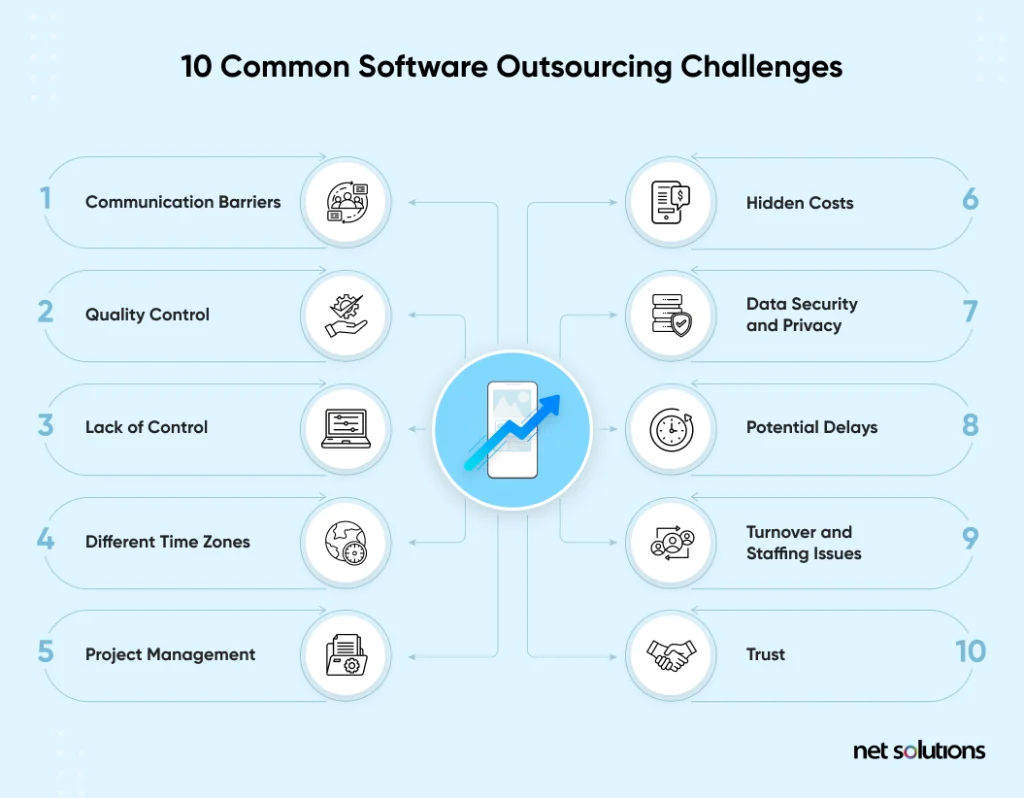Working with an outsourcing partner to support or manage your software development projects can be a cost-effective alternative to hiring or expanding an in-house team.
Talented outsourcing companies can increase efficiency, reduce time to market, and offer a competitive edge—but that doesn’t mean there aren’t potential challenges when outsourcing IT needs to an off-site development team.
As with all business challenges, the best way to manage risks is to understand them and address them head-on, which is why we’ve outlined the 10 most common challenges when working with an external software development team.
Why is Software Outsourcing Challenging?
We would love to tell you that outsourcing software development services to a nearshore or offshore team is always a seamless, efficient, and cost-effective process—after all, we’re an outsourcing company ourselves. You should, however, know all the facts.
Outsourcing runs the risk of miscommunication, and communication problems can be compounded by language barriers, cultural differences, and asynchronous work across different time zones. You may also face security risks and confidentiality concerns regarding your intellectual property, and that just scratches the surface.
Does this mean IT outsourcing is a bad idea? Absolutely not! The good news is that there are ways to mitigate these risks. When selecting the right partners, your return on IT outsourcing can be exceptional.
10 Common Software Outsourcing Challenges
Let’s explore the most common challenges organizations face when outsourcing, along with solutions for each one. You’ll discover the solution to time zone differences, security challenges, communication struggles, and more.
A strategic approach to outsourcing will help you build a software development process that taps into a worldwide talent pool and reaps the rewards of offshore software development.

Challenge #1: Communication barriers
There’s a reason IT outsourcing is so commonly associated with offshore development. While it’s possible to outsource projects to a company down the street, it’s far more cost-effective to work with a team located in a country with lower labor costs.
The downside to offshore development is that it can come with communication challenges and cultural barriers if the offshore team members aren’t fluent in English (or whatever your operating language happens to be). On top of that, they may struggle with poor communication when their English is adequate, simply because the provider hasn’t prioritized effective communication.
These issues will be compounded if your outsourced team doesn’t use a methodology like Agile and a DevOps approach, since modern methodologies facilitate stronger communication.
Solution: The solution to communication barriers is simple. Carefully vet any prospective software development company to verify their:
- Fluency in your operating language
- Project management skills
- Strategic approach to development (Agile, DevOps, or some other carefully considered methodology)
- Plan for regular communication at various milestones
When selecting a prospective partner, you can get a sense of their English skills and understanding of Western culture before the initial conversation, simply by reviewing the content on their website.
Do they have a video on their “About” page with staff interviews demonstrating English fluency? Do their blog posts and case studies approach a native-level command of the English language, or are they written in broken English?
There’s obviously no substitute for the interview, but if they struggle to explain themselves in written English and that’s your operating language, there’s no need to waste your time on a live conversation.
Challenge #2: Quality control
Outsourcing partners that fail to produce high-quality software products are a complete no-go, no matter what the cost-savings.
After all, if they fall short on their deliverables and the end product lacks the functionality you require, it could result in:
- Productivity loss related to poor internal software systems
- Business loss due to a poor customer experience
- Wasted resources (i.e., time and labor costs) dedicated to rework
Simply put, you need a software development partner that can deliver on your project requirements and get things right the first time. And quality assurance is 100% possible when your partner has the right systems in place.
Solution: Thoroughly vet prospective software development outsourcing partners to ensure they produce quality work. In other words, find a partner that has:
- A portfolio or work with case studies and testimonials to back up their claims
- Years of experience in high-quality custom software development
- Positive reviews on websites like Project managers who can clearly articulate their strategy for design and application development Clutch.co
- Project managers who can clearly articulate their strategy for design and application development
As mentioned above, they should also have clear systems for overcoming communication issues, as quality work and clear communication are integrally connected.
Challenge #3: Lack of control
One of the biggest potential drawbacks of working with an outsourcing team is that you give up full control over your project, data, and systems. Working with an in-house team is different because, even if you’ve got remote teams and employees, everything stays within your company’s network.
Giving up control over your project may present challenges because:
- Your service provider might go down a rabbit hole, failing to update you as much as you require
- Your outsourced team may not use the best project management tools, reducing transparency
- The outsourcing team has access to sensitive information, which can be a problem if they aren’t responsible stewards of your data
Solution: Whenever you work with an outsourcing partner, it’s important to choose a team that is transparent, handles data responsibly, and uses helpful project management tools. Regular meetings and updates are a must as well.
It’s also vital to spell out requirements in your contracts and have outside partners sign Non-Disclosure Agreements (NDAs) to protect your data. If you follow these tips, outsourcing software development projects will help you retain a significant degree of control over your project.
Challenge #4: Different time zones
When using outsourcing services in distant countries, time zone differences may present a challenge—assuming your dedicated team is unwilling to adapt to your work hours.
The good news is that some companies (including Net Solutions) are willing to adapt their work hours to yours if that’s what you require. We’re located in India, but we have no problem adjusting our work hours to wherever you are in the world.
Of course, in many cases, you may actually want an outsourcing partner to work asynchronously. That means you’ve got production happening around the clock!
For example, when Kitco hired Net Solutions to handle QA testing, the precious metals trading company saw the time difference as an advantage.
Kitco’s in-house software engineers worked normal hours, pounding out code during the day in the U.S. While their team slept, our QA team in India ran comprehensive tests and produced full bug reports—ready for Kitco’s product development team to address in the morning.
Solution: Evaluate the benefits and drawbacks of working asynchronously. If you decide your outsourcing partner should match your work hours, simply find a partner willing to adapt. If working asynchronously is ideal, then the time difference won’t impact your goals at all.
Challenge #5: Project management
Successful outsourcing requires strategic project management.
If you’re using an augmentation model where your in-house team manages projects from start to finish, you’ll need to develop systems that support collaboration and communication. If you’re using a full-service team and relying on their project management services, you’ll need to make sure they don’t drop the ball.
Strategic project management helps ensure that teams meet deadlines, communicate well, and produce quality code. If you’re using an Agile methodology, it results in well-managed sprints, solid feedback, and an efficient use of resources.
Simply put, some software development teams aren’t up to the task of project management. They may be good order takers, but relying on them to provide thorough project management might be asking for too much.
Solution: Whatever your outsourcing needs, work with teams that have experience with project management. Even if you have staff teams that handle your project management, hiring a team that is used to working with project management principles will help ensure clear communication and on-time fulfillment.
Challenge #6: Hidden costs
Outsourcing typically works on a pay-as-you-go model since it’s difficult to know in advance how a project will evolve.
For example, you might envision a certain set of features of your Minimum Viable Product (MVP), only to realize that additional functionality before the first release would offer a vital competitive edge. This would require additional hours of design, coding, and testing, which would impact the price
Solution: Work with an experienced software development team that is transparent about any factors that may impact the final price tag.
Challenge #7: Data security and privacy
Cybersecurity is absolutely vital in today’s world of security breaches and fraud, and failing to secure your customers’ data could leave you legally liable and destroy your brand.
Controlling risks begins with working with a reputable vendor with years of experience serving a range of industries and maintaining compliance. Even then, be sure to ask difficult questions from potential partners about their security and privacy protocols, and don’t work with anyone who isn’t up to the task and has a proven track record.
The truth is that security can be a challenge even when you don’t outsource your development to an outside team, as countless reputable organizations that have experienced breaches can attest to. Security risks will never disappear, but they can be managed, and it all starts with proper vetting.
Solution: Work with reputable, experienced firms and ask challenging questions about their approach to security.
Challenge #8: Potential delays
Delays are a common pitfall in software development, and when working with an outside team it can be even more challenging to keep them on track.
Sometimes delays arise from changing requirements or shifting priorities—these delays are difficult to avoid. However, when outsourcing partners fail to meet deliverables due to their own incompetence, it can be frustrating, to say the least.
When delays throw off launch dates and lengthen time-to-market, they can destroy your competitive edge. That’s why it’s important to avoid delays through proper vetting and clear planning.
Solution: Work with an experienced outsourcing firm that has a proven track record and positive testimonials. Outsourcing partners that miss deadlines on a regular basis don’t stay in business very long, nor do they collect positive reviews.
Also, be sure to implement project management and communication best practices to reduce the potential for delays.
Challenge #9: Turnover and staffing issues
Just as with full-time IT staff, some outsourcing companies experience excessive turnover. Those firms whose designers, developers, project managers, and testers serve short-lived stints will have a hard time serving their customers consistently.
After all, it takes a while to understand an industry and a product, so regular turnover means extra training and the need for additional feedback, likely producing delays.
Solution: Work with a provider that treats its employees well and has low staff turnover. During the vetting process, you can ask the provider what their average employee tenure is. Prioritize firms with low turnover.
Challenge #10: Trust
Trust comes into play on many levels. Working with a provider you trust means selecting someone with:
- Integrity
- A strong work ethic
- A dedication to optimizing code quality
- Transparency surrounding any roadblocks during the development process
Trust builds over time, but you can get off to the right start by working with a vendor whose track record you’ve reviewed.
Solution: Look at a potential partner’s customer reviews, terminals, and case studies, and trust your instincts after speaking to them on a video call. Millions of years of evolution have wired the human brain to make quick judgments about trustworthiness and integrity, so don’t ignore your gut if something feels off.
Being aware of these 10 common outsourcing challenges, and the solutions we’ve outlined, will help reduce the risks associated with outsourcing and increase your odds of success. While completely eliminating risk is impossible, a strategic approach can help you reap the many benefits outsourcing has to offer.
Overcoming Software Outsourcing Challenges
Every one of the outsourcing challenges outlined above can be mitigated, to some extent, by working with an experienced vendor that is aware of all the latest development and outsourcing trends.
Net Solutions has more than two decades of experience delivering quality software for world-renowned institutions like the Harvard Business Review and international enterprises like IMG, along with lean startups.
Talk to one of our specialists to see how Net Solutions can help you develop custom software from start to finish or augment the efforts of your in-house team.
SHARE THIS POST
Table of Contents
Related Resources
- 10 Key Benefits of Outsourcing Software Development
- 19 Best Software Development Outsourcing Companies in 2024
- How Much Does It Cost to Outsource Software Development?
- Software Development Outsourcing: India's Top 11 Contenders
- Comparing Software Development Outsourcing Models: A Decision-Maker's Guide
- A Guide to Nearshore Software Development Outsourcing [2024]
- Outsourcing Software Development: Evaluating the Pros and Cons
- 15 Questions to Ask when Outsourcing Software Development
- Outsourcing Software Development for Startups [2024 Guide]
- 2024 Software Development Outsourcing Statistics: Trends, Insights & Predictions
- Software Development Outsourcing Trends

